#Category 1946 films
Explore tagged Tumblr posts
Text

Avanti a lui tremava tutta Roma (1946, Carmine Gallone)
14/05/2024
#Avanti a lui tremava tutta Roma#film#1946#Carmine Gallone#anna magnani#Gino Sinimberghi#Tito Gobbi#Elisabetta Barbato#Tosca#giacomo puccini#Melodramma strappalacrime#Italian lira#Rinaldo Geleng#italy#Category 1946 films#black and white#Film genre#drama#romance film#musical theatre#war film#film director#Scriptment#screenplay#Gherardo Gherardi#Gaspare Cataldo#Casa di produzione cinematografica#Minerva film#film distribution#cinematographer
0 notes
Text
I was tagged by @memory-for-trifles for my top first-time watches in 2024 of movies not from 2024, and also by @door for my nine favorite movies of the year, which I am combining to nine non-recent releases. Thank you buddies!!
Also NOT thank you, as it seems I watched 190 new to me, pre-2024 movies last calendar year, and rated fully 45 of them five stars.
....so here is a representative nine categories (blood! tears!!), and then the whole list of older movies that fucking rule.
: :
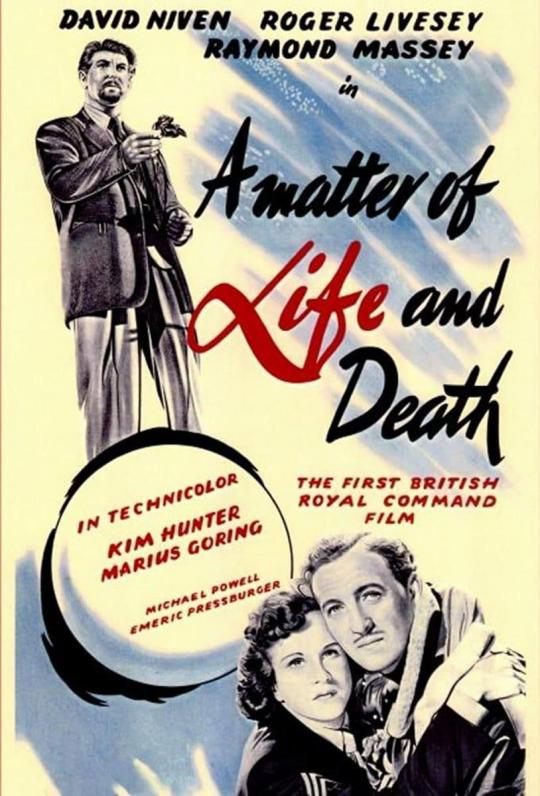


Powell & Pressburger: A Matter of Life and Death (1946) Pre-Code: Trouble In Paradise (1932) Screwball: It Happened One Night (1934)



Western: Dead Man (1995) Marty: Mean Streets (1973) Agnès: Le Bonheur (1965)



Historical: The Leopard (1963) Satyajit Ray: Pather Panchali (1955) Noir: Out of the Past (1947)
: :
Top 45 Non-2024 Movies I Watched in 2024 [alphabetical]
A Matter of Life and Death (1946) Powell & Pressburger Ace In the Hole (1951), Billy Wilder All About Eve (1950), Joseph L. Mankiewicz Bad Day at Black Rock (1955) John Sturges Daisies (1966) Věra Chytilová Dead Man (1995) Jim Jarmusch Cat People (1942) Jacques Tourneur It Happened One Night (1934) Frank Capra Johnny Guitar (1954) Nicholas Ray La Ronde (1950) Max Ophüls Laura (1944) Otto Preminger Le Bonheur (1965) Agnès Varda Little Women (1994) Gillian Armstrong Mean Streets (1973) Martin Scorsese Metropolitan (1990) Whit Stillman Miracle on 34th Street (1947) George Seaton Nights of Cabiria (1957) Federico Fellini On the Beach (1959) Stanley Kramer Only Angels Have Wings (1939) Howard Hawks Out of the Past (1947) Jacques Tourneur Pather Panchali (1955) Satyajit Ray Queen Christina (1933) Rouben Mamoulian Sunset Boulevard (1950) Billy Wilder The Age of Innocence (1993) Martin Scorsese The Awful Truth (1937) Leo McCarey The Best Years of Our Lives (1946) William Wyler The Big City (1963) Satyajit Ray The Fabulous Baron Munchausen (1962) Karel Zeman The Heiress (1949) William Wyler The Lady Vanishes (1938) Alfred Hitchcock The Leopard (1963) Luchino Visconti The Lodger: A Story of the London Fog (1927) Alfred Hitchcock The Manchurian Candidate (1962) John Frankenheimer The Philadelphia Story (1940) George Cukor The Red Shoes (1948) Powell & Pressburger The Servant (1963) Joseph Losey The Treasure of the Sierra Madre (1948) John Huston The Wind (1928) Victor Sjöström They Shoot Horses, Don’t They (1969) Sydney Pollack To Be or Not to Be (1942) Ernst Lubitsch Trouble in Paradise (1932) Ernst Lubitsch Ugetsu (1953) Kenji Mizoguchi Wait Until Dark (1967) Terence Young Wings of Desire (1987) Wim Wenders Zodiac (2007) David Fincher
Honorable Mentions
I had technically watched Casablanca (1942) and Brief Encounter (1945) many, many many many years earlier, but I rewatched both of them this past year as an adult, and guess what? Five star films.
Tagging @passingknightly, @knighthooded, @camestela, @bakingblues, @forshesajollygoodfellow, @alpineshepherdlass, @valentinsylve, and anyone else who enjoys a MOVIE
32 notes
·
View notes
Note
really have to thank the algorithm for putting your blog on my dash 🥰
& with that - hello!
will read through your review of “the six triple eight” later (exited for that, in terms of accuracy, even though i thoroughly enjoyed the movie ☺️👀) … but since you pointed out the scarcity of movies/ tv shows featuring the women during ww2 (& probably ww1, too), do you have any recs that fall into that category? or overall, what others did you enjoy?
have a nice day! 💖
Hi there!!! I'm glad you found me!! Welcome!
If after you read my long Six Triple Eight post you have any questions or wanna chat let me know! I love the WACs. I love the 6888th. I love talking about the WACs. Happy to chat.
Oh my god YES. YES I DO HAVE RECS. I devour all media with Women in WWII. Scarce as it may be. And finding a halfway decent representation is even harder to find. Here are some I really enjoy. They aren't perfect but I enjoyed them a lot.
Bomb Girls
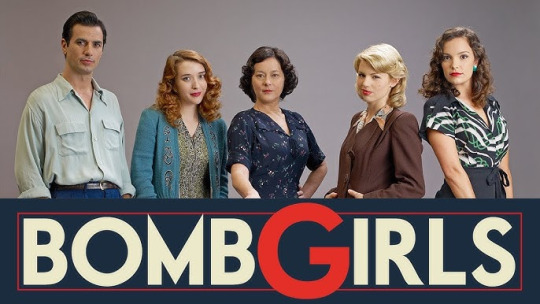
Bomb Girls is about the story of the women who joined a munitions factory in Canada during WWII. It's so good.
Lee
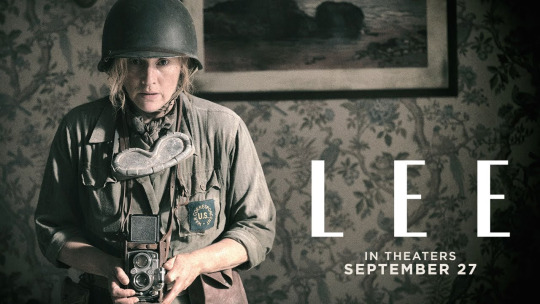
This just came out and yeah there were some mistakes/liberties taken but what movie doesn't at this point and it's about Lee Miller who is incredible and Kate Winslet killed it. Definitely give it watch.
All Creatures Great and Small

While not directly about women in the war, this show is one of my FAVORITES. It starts pre war and then goes into the war as the season move on. It's based on the book series that follow the adventures of James Herriot, a Scottish veterinary surgeon, who moves to Yorkshire in the 1930s/1940s. The women in this show are amazing. Helen runs her family farm. Mrs. Hall is the housekeeper but she basically runs everything and I adore her. You can see the homefront side of the war really well here.
The Land Girls (1998 film)
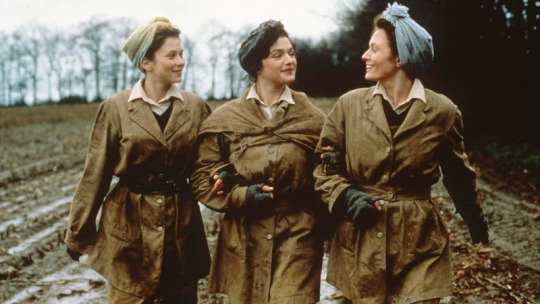
The film is about three young women from very different walks of life join the Women's Land Army during World War II and are sent to work together on a farm in Dorset.
There's also a tv series about the WLA called Land Girls but I freaking hated that show. Way too many inaccuracies and the way the women are portrayed made me so angry. This movie is far from perfect but I liked it enough.
Home Fires
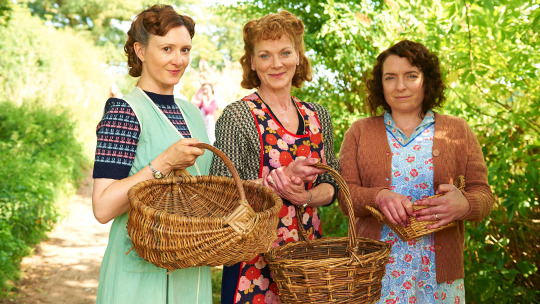
Okay so I haven't watched Home Fires yet but my mom has and she's as into wwii women's history as I am and she said I absolutely should put this on the list.
Home Fires is about group of women living in a rural Cheshire village during World War II who face the challenges of the home front during the war including rationing, the dangers of German bombing, and their loved ones going off to war.
A League of Their Own (the tv series AND the original movie)


Watch both of these!! I love them both so much!! I'm still so mad the show was cancelled.
A League of Their Own is about the women who joined the All American Girls Professional Baseball League and both the movie and the show are excellent. I mean the movie is a classic and I love it but the tv series goes into aspects of the League that the movie never touched. Like the women of color who weren't allowed to join the league and instead joined the men's leagues. And the fact that a lot of the women in the league were lesbians.
The Guernsey Literary and Potato Peel Pie Society
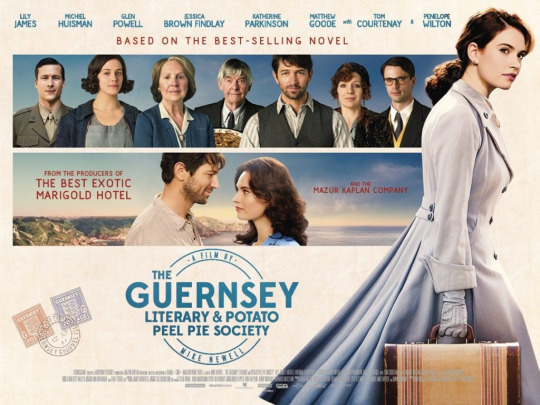
Based on a book, this movies is set in 1946. "A London-based writer begins exchanging letters with residents on the island of Guernsey, which was German-occupied during WWII. Feeling compelled to visit the island, she starts to get a picture of what it was like during the occupation." This movie is so good I cry every time. You get a look at life on the homefront and in a German occupied area. Lily James, Jessica Brown Findlay, Penelope Wilton, and Katherine Parkinson are all amazing and play such amazing female characters. Definitely watch it.
Charlotte Gray
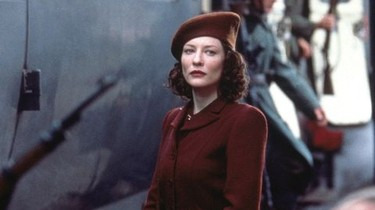
"A young Scottish woman joins the French Resistance during World War II to rescue her Royal Air Force boyfriend who is lost in France."
World on Fire
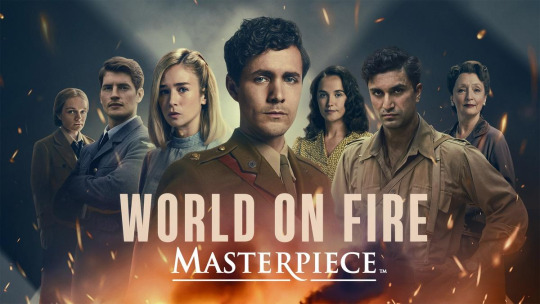
This one is hard show to watch but it's soo good. And it goes into some really interesting aspect of women's history. You've got homefront, military, resistance. France, Britain, Germany. Allied. Axis. A lot of roles are shown and it's impressive.
A Call To Spy
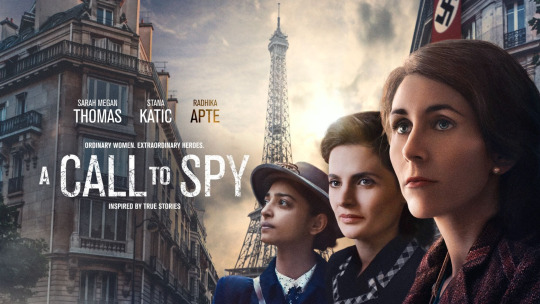
This movie is about the female members of the British SOE. Female spies! This one made me excited because the characters are Noor Inayat Khan, Virginia Hall, and Vera Atkins. Three real life female spies during the war.
So Proudly We Hail (1943)
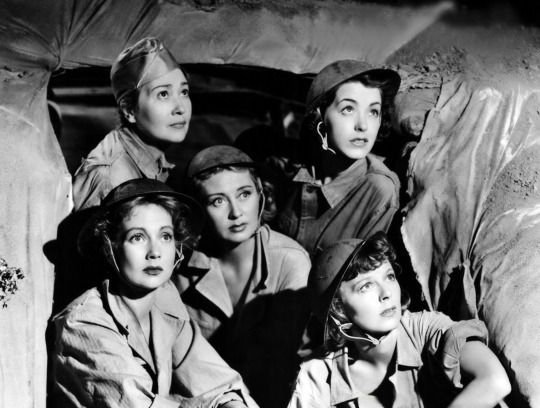
About US Army Nurses in the Pacific
Keep Your Powder Dry (1945)

A debutante (Lana Turner), a serviceman's bride (Susan Peters) and a girl (Laraine Day) from a military family join the Women's Army Corps.
And now I'm gonna give two WW1 recs too:
Anzac Girls
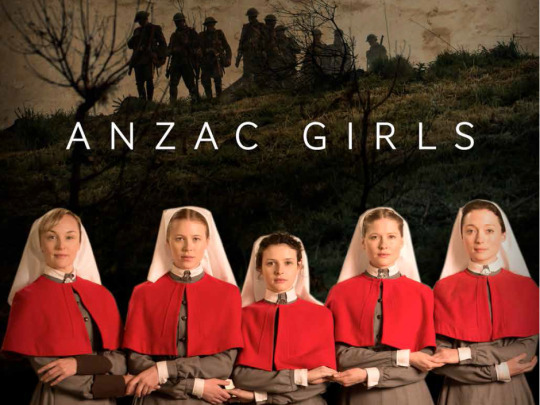
I adore this tv series so much. It's incredible. This is based on the Australian and New Zealand Army Nursing Service. Starts with their service in Egypt and then extends to France and the Greek Island Lemnos.
The Crimson Field
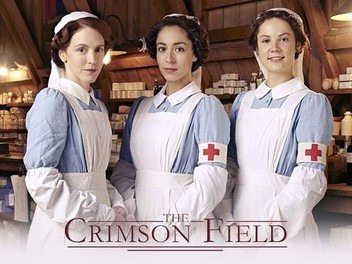
This tv series focuses on the VADs and other medical personnel who served in the field hospitals. SO GOOD! Still bitter it was cancelled.
I know I'm missing something but I'll leave off there for now. If I think of more I'll let you know!!
16 notes
·
View notes
Text

Two silhouetted figures in The Big Combo (1955). The film's cinematographer, John Alton, is sometimes credited as the creator of many of film noir's stylized images.
Film noir is a style of Hollywood crime dramas that emphasizes cynical attitudes and motivations. The 1940s and 1950s are generally regarded as the "classic period" of American film noir. Film noir of this era is associated with a low-key, black-and-white visual style that has roots in German expressionist cinematography. Many of the prototypical stories and attitudes expressed in classic noir derive from the hardboiled school of crime fiction that emerged in the United States during the Great Depression, known as noir fiction.
The term film noir, French for "black film" (literal) or "dark film" (closer meaning),was first applied to Hollywood films by French critic Nino Frank in 1946, but was unrecognized by most American film industry professionals of that era.Frank is believed to have been inspired by the French literary publishing imprint Série noire, founded in 1945.
Cinema historians and critics defined the category retrospectively. Before the notion was widely adopted in the 1970s, many of the classic films noir were referred to as "melodramas". Whether film noir qualifies as a distinct genre or whether it should be considered a filmmaking style is a matter of ongoing and heavy debate among film scholars.
Film noir encompasses a range of plots; common archetypical protagonists include a private investigator (The Big Sleep), a plainclothes police officer (The Big Heat), an aging boxer (The Set-Up), a hapless grifter (Night and the City), a law-abiding citizen lured into a life of crime (Gun Crazy), a femme fatale (Gilda) or simply a victim of circumstance (D.O.A.). Although film noir was originally associated with American productions, the term has been used to describe films from around the world. Many films released from the 1960s onward share attributes with films noir of the classical period, and often treat its conventions self-referentially. Latter-day works are typically referred to as neo-noir. The clichés of film noir have inspired parody since the mid-1940s.
More on Wikipedia
#film noir#The Big Combo#1955#crime movies#style#Nino Frank#French critic#Hollywood crime drama films#black and white#cinema
3 notes
·
View notes
Text
Noirvember: Mysterious Intruder (William Castle, 1946)

(This review contains spoilers which, while kept incredibly vague, might make certain developments in the plot less surprising)
The main reason I chose to watch Mysterious Intruder was because I wanted to watch something for Noirvember but had limited time, and this was only about an hour long. But it ended up being a pleasant surprise. It's a mystery, part of the mostly loosely connected "Whistler" seris, with some decent twists and turns, even if there could have been a few things done to make the mystery come together a bit more in the end. But I really liked that even though there was a murder, the murder wasn't the mystery itself, just an aspect of it.
The actually mystery is, I think, creative and interesting enough to set Mysterious Intruder apart, even if just a bit, from a lot of the cookie cutter low budget noir and noir-type movies from the era. The mystery centers on a girl and the reason the murdered shopkeeper wanted to find her. There's a really solid Macguffin at the center of the mystery, and it's kept a mystery for, in my opinion, the absolute perfect amount of time.
Really, I think despite the fact that it might not on its surface FEEL as nasty as some other noirs, there really is a lot of bleakness and nastiness to this one. A big reason for that is the characters, which I think ends up being bit of a double edged sword in the end. Richard Dix's dishonest cheat of a private detective is not one to sympathize with. He's not even in the category of noir antiheroes who are messy, or even bad people who end up being compelled to do the right thing. He's just a really awful person with selfish motivations throughout the who thing. I think that makes a great central character for a noir, and it's kind of surprising and even brave to make the central character so impossible to root for. Most of the people we spend significant time with are awful, which makes for a fascinating watch. But it does make it kind of hard to really grasp onto. The only two decent, sympathetic people - the shopkeeper who is murdered early on and the girl he's looking for, who we don't meet until well into the runtime - aren't around much or for long enough to really develop any kind of attachment, and that makes it really hard to connect with the story on an emotional level.
Still, though, I kind of respect that bold decision to mostly just let us spend time in an ugly world. It's deeply bleak, and it has an appropriately bleak ending. It also has one of the best twists I've seen in noir, and it happens pretty early in the movie. It's also really gorgeously filmed, and even though it's definitely a low budget noir, there are a lot of points where it looks more like one of the A-grade studio noirs like Double Indemnity or The Lady from Shanghai rather than one of the B-grade noirs like Detour or Night Editor.
I feel like the biggest problem with Mysterious Intruder is that, because the mystery is so focused around the girl and Macguffin, a big part of the mystery is killed when we're just introduced to the girl and shown where she's been the whole time without any of the characters actually discovering it. And since the focus of the mystery is on those things, once we meet the girl and discover why the shopkeeper wanted to find her and what the Macguffin is, there's no mystery surrounding who's looking for them and who's done the murdering. Which makes the climax feel pretty anticlimactic, even with its terrifically bleak ending.
I feel like Mysterious Intruder could have been a B-noir classic alongside stuff like Decoy and Detour if it had just a little more runtime to cook with. As it stands it's definitely impressive and worth the watch, but in the end it doesn't live up the what most of the runtime built up to.
#mysterious intruder#noirvember#film noir#classic film#my movie and tv stuff#movie reviews#richard dix#william castle
3 notes
·
View notes
Text
The complete list of films featured on this blog’s 2024 “31 Days of Oscar” marathon
Hello everyone,
Thank you once more for allowing me to present this annual marathon of Oscar-nominated films to your dashboards. This year, the films were grouped by category (for the most part, one day featured only films nominated in a particular category). This is the most exclusive period on this blog, as the selection of films that I can post and queue about is at its most limited. But at the same time, the blog is at its most accessible as this yearly marathon’s selection skews to more popular fare than what I usually queue. I hope you enjoyed this year’s presentation of 31 Days of Oscar once more!
What follows is the exhaustive list of all 381 short- and feature-length films featured on this blog over the last thirty-one days for the 31 Days of Oscar marathon. This is down from 2022’s record of 420. But that count remains only a fraction of the 5,145 films that have been nominated for Academy Awards since 1927 (excluding Honorary Oscar winners that weren't nominated in a competitive category).
Of those 382, 28 were short films (53 short films is the record, which was set in 2022). 354 were feature films.
BREAKDOWN BY DECADE 1927-1929: 10 1930s: 51 1940s: 54 1950s: 44 1960s: 42 1970s: 26 1980s: 26 1990s: 23 2000s: 26 2010s: 26 2020s: 54
TOTAL: 382 (380 last year)
Year with most representation (2023 excluded): 1938 and 1942 (9 films each) Median year: 1966
Time for the list. 59 Best Picture winners and the one (and only) winner for Unique and Artistic Production that I featured this year are in bold. Asterisked (*) films are films I haven’t seen in their entirety as of the publishing of this post. Films primarily not in the English language are accompanied with their nation(s) of origin.
The ten Best Picture nominees for the 96th Academy Awards, including the winner, Oppenheimer (2023)
The fifteen nominees in the short film categories for the 96th Academy Awards
À nous la liberté (1931, France)
The Adventures of Don Juan (1938)*
The Adventures of Robin Hood (1938)
Albert Schweitzer (1957)*
Alexander’s Ragtime Band (1938)
Alice Adams (1935)*
Alice Doesn't Live Here Anymore (1974)*
Aliens (1986)
All About Eve (1950)
All Quiet on the Western Front (1930)
All That Jazz (1979)*
Amadeus (1984)
Amarcord (1973, Italy)
An American in Paris (1951)
An American Werewolf in London (1981)*
Anatomy of a Murder (1959)
Anne of the Thousand Days (1969)*
The Apartment (1960)
Aquamania (1961 short)
Autumn Sonata (1978, Sweden)
Avatar (2009)
Avatar: The Way of Water (2022)
The Awful Truth (1937)
The Bad and the Beautiful (1952)
Bad Day at Black Rock (1955)
The Band Wagon (1953)
The Barefoot Contessa (1954)
Batman (1989)
Beauty and the Beast (1991)
Becket (1964)*
Before the Rain (1993, Macedonia)*
Ben-Hur (1959)
The Best Years of Our Lives (1946)
Bicycle Thieves (1948, Italy)
The Big Country (1958)
The Big House (1930)
Black Narcissus (1947)
The Black Swan (1942)
BlacKkKlansman (2018)
Blazing Saddles (1974)
Blue Valentine (2010)*
Bonnie and Clyde (1967)
Born Yesterday (1950)*
The Boy and the Heron (2023, Japan)
Bram Stoker's Dracula (1992)*
Braveheart (1995)
Brief Encounter (1945)
Brigadoon (1954)
Bullitt (1968)
Butterflies Are Free (1972)*
Cabaret (1972)
Caged (1950)
The Caine Mutiny (1954)
Can You Ever Forgive Me? (2018)
Captain Blood (1935)
Casablanca (1942)
Cavalcade (1933)
Chico and Rita (2010, Spain)
Children of a Lesser God (1986)
The Children of Theatre Street (1977)*
Cimarron (1931)
The Circus (1928)
Citizen Kane (1941)
Cleopatra (1963)
A Clockwork Orange (1971)
CODA (2021)
The Color Purple (1985)
Come and Get It (1936)*
Common Threads: Stories from the Quilt (1989)*
El Conde (2023, Chile)*
Cool Hand Luke (1967)
The Country Girl (1954)*
Cries and Whispers (1972, Sweden)*
Crossfire (1947)
Crouching Tiger, Hidden Dragon (2000, Taiwan)
The Crowd (1928)
Dances with Wolves (1990)
Dangerous (1935)*
Days of Waiting (1991 short)*
The Deer Hunter (1978)
The Departed (2006)
Desert Victory (1942)*
Disraeli (1929)*
The Divine Lady (1929)*
Doctor Zhivago (1965)
Dodsworth (1936)
Double Indemnity (1944)
Dr. Jekyll and Mr. Hyde (1932)
Dr. Jekyll and Mr. Hyde (1941)
Dr. Jekyll and Mr. Mouse (1947 short)
Drive My Car (2021, Japan)
Driving Miss Daisy (1989)
Dune (2021)
8½ (1963, Italy)
Elemental (2023)
The Elephant Whisperers (2022 short, India)
Elmer Gantry (1960)
Emma (1932)*
The Empire Strikes Back (1980)
Encanto (2021)
The English Patient (1996)
Ernest & Celestine (2012, Belgium/France/Luxembourg)
The Eternal Memory (2023, Chile)
Eternal Sunshine of the Spotless Mind (2004)*
Everything Everywhere All At Once (2022)
Fantastic Voyage (1966)
Far From Heaven (2002)*
A Farewell to Arms (1932)
Fiddler on the Roof (1971)
The Firemen’s Ball (1967, Czechoslovakia)*
Five Star Final (1931)*
Flee (2021, Denmark)
Flower Drum Song (1961)
For All Mankind (1989)
Forbidden Planet (1956)
Foreign Correspondent (1940)
Forrest Gump (1994)
42nd Street (1933)
Four Daughters (1938)*
Four Daughters (2023, France/Germany/Tunisia/Saudi Arabia)*
Freedom on My Mind (1994)
Frida (2002)*
The Front Page (1931)*
Funny Girl (1968)
Gandhi (1982)
Gaslight (1944)
Gentleman’s Agreement (1947)
Giant (1956)
Gladiator (2000)
The Godfather (1972)
The Godfather Part II (1974)
Godzilla Minus One (2023)
Gold Diggers of 1933 (1933)
Goldfinger (1964)
Gone with the Wind (1939)
The Goodbye Girl (1977)
Goodbye, Mr. Chips (1939)
Gosford Park (2001)
Grand Prix (1966)
The Grandmaster (2013, Hong Kong/China)*
The Grapes of Wrath (1940)
The Great Dictator (1940)
Great Expectations (1946)*
The Great Race (1965)
Green Dolphin Street (1947)*
Guess Who’s Coming to Dinner (1967)
Gunfight at the O.K. Corral (1957)
Gypsy (1962)*
Hamlet (1948)
The Heiress (1949)
Henry V (1944)
Henry V (1989)
Hercules (1997)
Here Come the Waves (1945)*
High Noon (1952)
How Green Was My Valley (1941)
How the West Was Won (1962)
How to Train Your Dragon: The Hidden World (2019)
The Hunchback of Notre Dame (1939)
The Hundred-Year-Old Man Who Climbed Out of the WIndow and Disappeared (2013, Sweden/France Germany)
The Hurt Locker (2008)
If Anything Happens I Love You (2020 short)
In America (2003)*
In the Heat of the Night (1967)
Indiana Jones and the Dial of Destiny (2023)
The Informer (1935)
Investigation of a Citizen Above Suspicion (1970, Italy)*
Io Capitano (2023, Italy)*
It Happened One Night (1934)
JFK (1991)*
Juno (2007)
Kung Fu Panda (2008)
Lady for a Day (1933)
The Last Command (1927)
The Last Emperor (1987)
The Last Picture Show (1971)
Laura (1944)
Lawrence of Arabia (1962)
A Letter to Three Wives (1949)
Life Is Beautiful (1997, Italy)
Lilies of the Field (1963)
Lincoln (2012)
The Little Foxes (1941)*
Lolita (1962)
The Longest Day (1962)
The Lord of the Rings: The Return of the King (2003)
The Lost Weekend (1945)
Love Affair (1939)*
The Love Parade (1929)
Love Is a Many-Splendored Thing (1955)
Loving Vincent (2017)
Lust for Life (1956)
The Magnificent Ambersons (1942)
Malcolm X (1992)
A Man for All Seasons (1966)
The Man Who Knew Too Much (1956)
The Man Who Skied Down Everest (1975)
March of the Penguins (2005, France)
Marie Antoinette (1938)*
Marty (1955)
Mary Poppins (1964)
Meet Me in St. Louis (1944)
Merrily We Live (1938)*
The Merry Widow (1934)
Mickey’s Orphans (1931 short)
Midnight in Paris (2011)
Milk (2008)*
Million Dollar Baby (2004)
Minari (2020)
Miracle on 34th Street (1947)
The Miracle Worker (1962)*
Mogambo (1953)*
Moneyball (2011)*
Monsieur Hulot's Holiday (1953, France)
Monsieur Lazhar (2011, Canada)
Moonstruck (1987)*
The More the Merrier (1943)
Mr. Deeds Goes to Town (1936)
Mrs. Miniver (1942)
Munich (2005)*
The Music Man (1962)
My Fair Lady (1964)
My Man Godfrey (1936)*
Napoleon (2023)*
National Velvet (1944)
Naughty Marietta (1935)*
Network (1976)
Never on Sunday (1960, Greece)*
Nimona (2023)
No Country for Old Men (2007)
None But the Lonely Heart (1944)*
North by Northwest (1959)
Now, Voyager (1942)
The Nun’s Story (1959)
Odd Man Out (1947)*
On Golden Pond (1981)
On the Waterfront (1954)
Out of Africa (1985)
Papillon (1973)
Parasite (2019, South Korea)
A Passage to India (1984)*
Patton (1970)
Penny Serenade (1941)
Perfect Days (2023, Japan)*
Persepolis (2007, France)
Phantom Thread (2017)
The Philadelphia Story (1940)
Pillow Talk (1959)
Planet of the Apes (1968)
Platoon (1986)
Pollock (2000)*
Popeye the Sailor Meets Sindbad the Sailor (1936 short)
The Pride of the Yankees (1942)
The Prince of Egypt (1998)
The Prisoner of Zenda (1937)
The Private Lives of Elizabeth and Essex (1939)*
The Public Enemy (1931)
Pulp Fiction (1994)
Pygmalion (1938)
Quo Vadis (1951)
The Quiet Man (1952)
Raging Bull (1980)
Raiders of the Lost Ark (1981)
Rain Man (1988)
Raintree County (1957)*
Random Harvest (1942)
Rashômon (1950, Japan)
The Razor's Edge (1946)
Rebecca (1940)
Rejected (2000 short)
Return of the Jedi (1983)
Rhapsody in Rivets (1941 short)*
The Robe (1953)*
Robin Hood: Prince of Thieves (1991)*
Robot Dreams (2023, Spain)
Rocky (1976)
Roma (2018, Mexico)
Roman Holiday (1953)
Room (2015)
Rustin (2023)*
Sadie Thompson (1928)*
Schindler's List (1993)
Searching for Sugar Man (2012)
Seconds (1966)*
Sergeant York (1941)
7 Faces of Dr. Lao (1964)
7th Heaven (1927)*
Shall We Dance (1937)
The Shawshank Redemption (1994)
She Wore a Yellow Ribbon (1949)
The Shop on Main Street (1965, Czechoslovakia)
Silence (2016)*
The Silence of the Lambs (1991)
The Silent Child (2017 short)
The Sin of Madelon Claudet (1931)
Singin' in the Rain (1952)
The Sixth Sense (1999)*
Society of the Snow (2023, Spain)*
The Sound of Music (1965)
Spellbound (1945)
Spider-Man: Across the Spider-Verse (2023)
Spotlight (2015)
Stagecoach (1939)
A Star Is Born (1937)
A Star Is Born (1954)
Star Trek: First Contact (1996)
Star Trek IV: The Voyage Home (1986)
Star Trek VI: The Undiscovered Country (1994)
Star Wars (1977)
Star Wars: The Force Awakens (2015)
Star Wars: Episode I – The Phantom Menace (1999)
Star Wars: Episode III – Revenge of the Sith (2005)
The Sting (1973)
La Strada (1954, Italy)
A Streetcar Named Desire (1951)
Strike Up the Band (1940)
Sun Valley Serenade (1941)
Sunrise: A Song of Two Humans (1927)
Sunset Boulevard (1950)
Superman (1978)
Superman Returns (2006)
Suspicion (1941)
The Tale of the Princess Kaguya (2013, Japan)
A Tale of Two Cities (1935)*
The Teachers’ Lounge (2023, Germany)
Terms of Endearment (1983)
Test Pilot (1938)*
The Thief of Bagdad (1940)
The Thin Man (1934)
To Kill a Mockingbird (1962)
Tom Jones (1963)*
The Tragedy of Macbeth (2021)
The Triplets of Belleville (2003, France)
12 Angry Men (1957)
20 Days in Mariupol (2023, Ukraine)
2001: A Space Odyssey (1968)
The Two Mouseketeers (1952 short)
Up (2009)
The Valley of Decision (1945)*
Vicky Cristina Barcelona (2008)*
War Horse (2011)
West Side Story (1961)
Whiplash (2014)
The White Helmets (2016 short)
Who Framed Roger Rabbit (1988)
The Window (1949)*
Wings (1927)
Winnie the Pooh and Tigger Too (1974 short)
Witness for the Prosecution (1957)
The Wizard of Oz (1939)
The Woman in Red (1984)*
Woman in the Dunes (1964, Japan)*
Written on the Wind (1956)*
Wuthering Heights (1939)
Yankee Doodle Dandy (1942)
You Can’t Take It with You (1938)
7 notes
·
View notes
Text
2023 recap
tagged by @grusinskayas, thanks so much mari! <3 I'll tag @nitrateglow @oftwodarkmoons @valancystirling48 @lilbabylovergirl @jwclapton @nataliawoods @olivethomas @ritahayworrth @emmybrown @gayworths @astonishinglysane @womansfilm @davisbette @daniellesdarrieux only if you want to of course! and anyone else who wants to do this please do! (and tag me!) Only including things that were new to me this year in each category or the lists would be far too long!
top films: I just did the 9 favorite first watches post which were, -The Dream Lady (1918) -Danger Love at Work (1937) -The Cowboy and the Lady (1938) - Pillow to Post (1945) - Home Sweet Homicide (1946) -Turn the Key Softly (1953) - Minari (2020) -Mrs. Harris Goes to Paris (2022) -Everything Everywhere All At Once (2022)
and I will add some more on to that as well! -Husband Hunters (1927) -Sunny (1930) -Honeymoon Limited (1935) -East Side of Heaven (1939) -Spring Parade (1940) -The Face Behind the Mask (1941) -Marriage is a Private Affair (1944) -This Happy Breed (1944) -Guest Wife (1945) -Molly and Me (1945) -The Wicked Lady (1945) -An Ideal Husband (1947) -Deep Valley (1947) -Night Tide (1961) -The Glass Bottom Boat (1966) -The Grass Harp (1995) -Luca (2021)
top tv series: I have such a hard time remembering what tv shows I watch throughout the year as I don't keep track of them the way I do movies but this is encouraging me to start making lists from now on.
From what I can remember - -All Creatures Great and Small -Sanditon -The Great Canadian Baking Show -The Tenant of Wildfell Hall -Only Murders in the Building -It's a Living -Call The Midwife top books: Did not read much this year and hardly anything new but here are a few I liked!
-The Surgeon's Daughter, Audrey Blake -The Leavenworth Case, Anna Katharine Green -The Tenant of Wildfell Hall, Anne Brontë -The Secret Book of Flora Lea, Patti Callahan Henry
favorite song: This is going to be a long section!
Firstly my pride and joy, the playlist of expressing love of nature through music (mostly folk music but some others mixed in) that I worked so hard on at the beginning of the year. A lot of it is not new to me songs but some of it is and mostly making a playlist is new to me. Flower, Flower Oh My Love Playlist. Now for some individual songs I discovered and loved throughout the year~ (choosing max of one song per artist that is also not included in my playlist or this will get way too long)
-Alvvays - Pecking Order -Aurora - Your Blood -Blackbriar - Fairy of the Bog -Cécile Corbel - Come Back Home -chirinuruwowaka - bakenokawa -Coco - Fantasy -hemlocke springs - sever the blight -Laufey - Bewitched -MARINA - Man's World -Maxine Sullivan - Skylark -Mylène Farmer - Sans contrefaçon -Paramore - This Is Why -Pomme - La rivière -Ruby Throat- In the Arms of Flowers -yanaginagi - More Than Enough -Yutori - One Room
favorite quote: - "listen, this would be a better world if there was more singing and less dictating." - East Side of Heaven, 1939
-"When all inside you burns like a star It's after you burn out that you are Reborn again, reborn again
And maybe if you called out for help Then I could help you outrun yourself Come run again, we'll run again" - Your Blood, Aurora
12 notes
·
View notes
Text
William Wyler: A Master Filmmaker Revisited

By Jay Rozgonyi
Associate Vice Provost for Pedagogical Innovation & Effectiveness
Director, Center for Academic Excellence
Instructor of both Educational Technology and Film Studies
How about this for a great Final Jeopardy question under the category The Oscars: “He’s the Hollywood director with the most Best Director nominations (12), the most Best Picture nominations (13), and the most acting nominations in his films (36).” Pretty good, I’d say. But chances are that the question will never be used—not because I’m not a staff writer for the show, but also because the answer would likely be considered too hard for most contestants, even serious film fans.
That they wouldn’t be able to name William Wyler is unfortunate, as he was one of the truly great filmmakers of the 20th century. A lot of his movies are well known: Wuthering Heights, Ben-Hur, Roman Holiday, Mrs. Miniver, The Best Years of Our Lives, Funny Girl… I could go on and on. But unlike Alfred Hitchcock and suspense, or John Ford and Westerns, Wyler didn’t focus on a particular genre; instead—as the list of films I just mentioned demonstrates—he moved from comedy to drama to romance to historical epic. Because of that, he was brushed aside by the critics of the 1960s and 1970s, who considered him a gifted Hollywood studio director but thought that he lacked a coherent artistic vision. In fact, Wyler’s highly diverse output was the result of a quest for innovation and a desire to challenge himself by always trying something new throughout a career that lasted nearly 50 years.
If you Google William Wyler filmmaking style, you’ll learn about the way he carefully composed his shots, staggered his actors from deep in the frame to extremely close up, and staged dialogue scenes with few cuts so all the characters are visible at the same time—all directorial techniques that demonstrate his meticulous craftsmanship. I see another element to his films, however, which hasn’t received much attention at all: a steadfast attention to social justice and basic human morality. Once you look for these themes, it’s as easy to spot as his striking camera setups and his precise use of light and shadow. Wyler’s firm sense of conscience comes out in the nuances of his stories and the characters who inhabit them, and in the subtle ways they speak to the issues of their respective days. We see it in 1937’s Dead End, where the Depression has left families broken and juveniles with little sense of hope for their future. We see it in 1946’s The Best Years of Our Lives, where GIs returning from World War II confront a home front that seems to have moved beyond them and their sacrifices, and toward a future focused on making money and assailing anyone who might be a “Commie.” And we see it in 1970’s The Liberation of L.B. Jones, Wyler’s last film and in many ways his most courageous—a brutally honest look at racism in America and the dehumanization it brings upon us all.
Over the course of 2024, Fairfield University is celebrating the career of William Wyler with an undergraduate course devoted to his work, a series of film screenings at the Fairfield Bookstore on the Post Road, and an exhibition of materials from his private collection titled William Wyler: Master Filmmaker, Man of Conscience, which will be on display at the DiMenna-Nyselius Library from September through December. We’re just a few years away from the 125th anniversary of Wyler’s birth in 1902, so this seems like a good time for a lot more people to get acquainted with the man and his films. Then, perhaps, by 2027, the Final Jeopardyanswer might even be too easy for contestants to ponder. Wouldn’t that be nice?
Fairfield University’s celebration of the life and work of William Wyler would not be possible without the generous support of his daughters, Catherine and Melanie Wyler. We thank them for all that they’ve done to enable us to share their father’s work with our community.
The following movie screenings will be open to the public at 6:30 p.m. on these dates at the Fairfield University Downtown Bookstore, located at 1499 Post Road, Fairfield, Conn.:
April 9: The Best Years of Our Lives (1946); guests: Melanie Wyler (in person) and Catherine Wyler (via Zoom).
October 1: The Desperate Hours (1955); guests: Melanie Wyler (in person) and Catherine Wyler (via Zoom); other Wyler family members may attend via Zoom.
November 19: The Liberation of L.B. Jones(1970); guests: Melanie Wyler (in person) and Catherine Wyler (via Zoom); other Wyler family members may attend via Zoom.
#Fairfield University#Jay Rozgonyi#William Wyler#The Best Years of Our Lives#The Desperate Hours#The Liberation of L.B. Jones#Wuthering Heights#Dead End#Ben-Hur#Roman Holiday#Mrs. Miniver#Funny Girl#Oscars
3 notes
·
View notes
Text
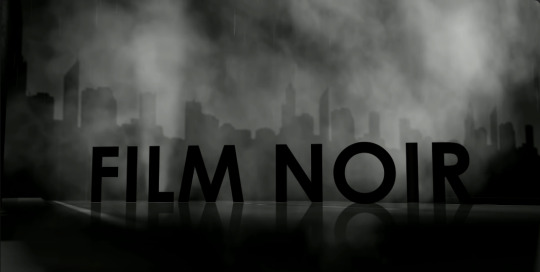







Film noir; French: [film nwaʁ]) is a cinematic term used primarily to describe stylish Hollywood crime dramas, particularly those that emphasize cynical attitudes and motivations. The 1940s and 1950s are generally regarded as the "classic period" of American film noir. Film noir of this era is associated with a low-key, black-and-white visual style that has roots in German Expressionist cinematography. Many of the prototypical stories and much of the attitude of classic noir derive from the hardboiled school of crime fiction that emerged in the United States during the Great Depression.
The term film noir, French for 'black film' (literal) or 'dark film' (closer meaning), was first applied to Hollywood films by French critic Nino Frank in 1946, but was unrecognized by most American film industry professionals of that era. Frank is believed to have been inspired by the French literary publishing imprint Série noire, founded in 1945.
Cinema historians and critics defined the category retrospectively. Before the notion was widely adopted in the 1970s, many of the classic films noir were referred to as "melodramas". Whether film noir qualifies as a distinct genre or whether it is more of a filmmaking style is a matter of ongoing and heavy debate among scholars. Film noir encompasses a range of plots: the central figure may be a private investigator (The Big Sleep), a plainclothes police officer (The Big Heat), an aging boxer (The Set-Up), a hapless grifter (Night and the City), a law-abiding citizen lured into a life of crime (Gun Crazy), a femme fatale (Gilda) or simply a victim of circumstance (D.O.A.). Although film noir was originally associated with American productions, the term has been used to describe films from around the world. Many films released from the 1960s onward share attributes with films noir of the classical period, and often treat its conventions self-referentially. Some refer to such latter-day works as neo-noir. The clichés of film noir have inspired parody since the mid-1940s.
3 notes
·
View notes
Text

John Wayne and Montgomery Clift in Red River (Howard Hawks, 1948)
Cast: John Wayne, Montgomery Clift, Joanne Dru, Walter Brennan, Colleen Gray, Harry Carey, John Ireland, Noah Beery Jr., Harry Carey Jr., Chief Yowlatchie, Paul Fix, Hank Worden. Screenplay: Borden Chase, Charles Schnee, based on a story by Chase. Cinematography: Russell Harlan. Art direction: John Datu. Film editing: Christian Nyby. Music: Dimitri Tiomkin.
You know those social media posts that ask you to name the movies you've watched more than five times that you would still watch again? I don't respond to them because there are too many movies that fit the category for me, but Red River would certainly be on my list. Each time I watch it, I have a little different reaction. Sometimes, for example, I'm glad when the character of Tess Millay (Joanne Dru) shows up, because it's kind of a relief from all that male bonding of the cattle drive. Other times, she annoys me. She's the "Hawksian woman" of the movie, the character embodied so well by Jean Arthur in Only Angels Have Wings (1939), Rosalind Russell in His Girl Friday (1940), and especially Lauren Bacall in To Have and Have Not (1944) and The Big Sleep (1946). The Hawksian woman talks back to men, asserting her place in the world they dominate. But Tess Millay just talks, and even talks about how much she talks. Moreover, she's obviously there primarily to serve as a reincarnation of Fen (Colleen Gray), the woman whom Tom Dunson (John Wayne) loved and lost when he left the wagon train at the beginning of the movie. Still, even this bit of unnecessary narrative linkage is forgivable in a movie that offers so much. There is, of course, what I think of as Wayne's best performance as Dunson -- some prefer his work in The Searchers (John Ford, 1956), which I find too artfully staged by Ford. Here he shows he can do everything from Hawks's characteristic swiftly overlapping dialogue to the paranoid trail-boss martinet to the tough guy hiding his tender side. And there's Montgomery Clift's remarkable movie debut as Matthew Garth; Red River was filmed before The Search (Fred Zinnemann, 1948), though the latter was released first. Clift, who was stage-trained, seems to have instinctively learned that movie acting is done in large part with the face, and he uses his eyes particularly expressively -- he reminds me of the great silent film actors in that regard. The scene in which Garth and Cherry Valance (John Ireland) handle each other's guns is one of the great homoerotic moments in movies, but it's prepared for by the way Clift and Ireland look at each other when they first meet, sizing each other up. And then there's one of the great supporting casts in movies, including Walter Brennan, Noah Beery Jr., and a whole lot of cattle. (Hawks, who also produced the film, graciously gave Arthur Rosson, the second unit director in charge of the cattle drive scenes, a co-director credit.) Dimitri Tiomkin's music added immeasurably to the film, but surprisingly went unnominated by the Academy, which took notice only of Christian Nyby for editing and Borden Chase for the film's story. (It was based on his story in the Saturday Evening Post, and was turned into a screenplay by Charles Schnee -- though a lot of the dialogue is so Hawksian that I suspect the director deserved a screenplay credit, too.) Naturally, like most Hawks films, it won no Oscars.
6 notes
·
View notes
Text

Castle Class NZ – HMNZS Maimai (T27/T338) HMNZS Maimai (T27) (T338) some pics of the crew – The ship was launched on February 25, 1943 at the Stevenson & Cook shipyard in Dunedin , and entered the Royal New Zealand Navy in 1944. The unit was withdrawn from service in 1946. HMNZS Maimai (T27) (T338) – New Zealand minesweeper from the period of World War II , one of the thirteen built units of type Castle . The ship was launched on February 25, 1943 at the Stevenson & Cook shipyard in Dunedin , and entered the Royal New Zealand Navy in 1944. The unit was withdrawn from service in 1946. Maimai served in the RNZN for only two years, initially marked with a side mark T27, then changed to T338 [2] . It was written from the fleet list in 1946 and then sold to the fishing sector. https://pl.wikipedia.org/wiki/HMNZS_Maimai Customize buttons Like this: https://widgets.wp.com/likes/?ver=14.4#blog_id=231365583&post_id=1747&origin=rnznships.com&obj_id=231365583-1747-67cf78f160588 HMNZS Maimai (T27) (T338) by John 19 May 2024 HMNZS Maimai was one of eight steel New Zealand-built Castle-class ships built and commissioned by the Royal New Zealand Navy during World War II. HMNZS Maimai with HMS Indefatigable in the Marlborough Sounds – 1945 HMS Indefatigable with HMNZS Maimai alongside her, Maimai was acting as a store ship for Indefatigable. Photo from Auckland Libraries heritage image collection (PHOTO ID:370_0299_07) HMNZS Maimai & her crew Castle Class at HMNZS Cook, Shelly Bay, Wellington ST Maimai Steaming up Wellington Harbour, 1960s HMNZS Maimai (T27) (T338) Maimai being tended to by the Fire Brigade after waste oil in her bilges caught fire. Maimai being broken up on the Evans bay slipway in 1966, she was broken up in 6 weeks. Film of Maimai being broken up exists but is yet to be digitized. HMNZS Maimai was one of eight steel New Zealand-built Castle-class ships built and commissioned by the Royal New Zealand Navy during World War II. Background[edit] The vessel was ordered after the New Zealand government, facing a requirement for more minesweepers to operate in home waters, chose the Castle-class design because it was simple enough to be built with the country’s limited ship construction facilities at the time.[1] Operational history[edit] Maimai was the fourth of the nine steel minesweepers constructed for the Royal New Zealand Navy and was commissioned on 15 September 1943. the others being Aroha, Awatere, Hautapu, Pahau, Waiho, Waima, Waipu, and Waikato (never commissioned). She served with the 95th Auxiliary Minesweeping Group, located at Wellington.[2] In March 1944, Maimai would accidentally fire her port depth charge thrower while berthed at Picton.[3] The unexploded depth charge was recovered four weeks later.[3] On 27 July 1945, she was rammed by Awatere stern-to-stern at Shelly Bay, with minor damage.[3] After the war, Maimai was disarmed but remained in service for ammunition dumping.[3] In 1946, Maimai was purchased by the Maimai Trawling Company Ltd. to be used as a side trawler.[3][2] In 1947 she caught nearly 100,000 lb (45,000 kg) of fish, being considered a record for four days of fishing at the time.[4] On 28 July 1950, waste oil in Maimai‘s bilges caught fire, but was quickly extinguished by the Wellington Fire Brigade.[5][6] As the years went by, catches got smaller and smaller, with conditions onboard of Maimai deteriorating. [7] And with smaller and efficient fishing vessels being built, it became harder for Maimai to get a crew, with Maimai still sailing without a full crew.[7] At the end of 1966, Maimai was sold for scrap and was scrapped in Wellington by Pacific Scrap Ltd Tags and categories: Castle Class NZ, Castle Class NZ – HMNZS Maimai (T27/T338) via WordPress https://ift.tt/bA39vId March 11, 2025 at 12:49PM
0 notes
Text

David Lynch
1946-2025.
David Lynch, one of the greatest and most singular filmmakers of our his generation has died and it is almost a certainty that we will never see his like again. A meticulous craftsman whose films – Eraserhead, Mulholland Drive, Inland Empire, Lost Highway, Twin Peaks: Fire Walk With me among others – looked like they sprang fully formed from the deepest corners of his psyche, dreams (and nightmares) injected straight into ours. His work touched on horror, film noir, melodrama and a bizarre kind of deadpan slapstick even as he made hash of categories, painting an American surrealism that was a psychogeography of everything hidden around and within us. When I look back on what is a deceptively small number of films (10 features but also multiple shorts, a landmark TV series, albums, paintings, a newspaper strip) I think of actors and their faces – Kyle MacLachlan finding to his horror what he’s capable of while Dennis Hopper turns his face into a mask of rage and desire focused on Isabella Rosellini, his victim fatale, her own face splitting the difference between lust and desperation (“Put your disease into me”) in Blue Velvet (1986) ; Naomi Watts morphing from a fresh-faced Nancy Drew on the tail of a mystery into a hollowed-out junkie who’s seen more than anybody should handle in Mulholland Drive (2001); Bill Pullman speeding down a Lost Highway (1997), full of adrenalized despair; Jack Nance melting into urban inertia in Eraserhead (1978); Sheryl Lee’s horror finding her worst fears closer than she dared dream on the way to becoming one of film’s most fetishized corpses in the Twin Peaks movie (1992) – a gallery of characters taking their players to unmatchable extremes that Lynch spreads across a country of sordid cabarets, car crashes or small towns full of bugs. The last I saw of him he was playing John Ford for Steven Spielberg and of the three titans there was no question of which one forged my cinematic worldview the most. I’ll never be shed of David Lynch. He put his disease in me.
0 notes
Text
Rising Above
For my last article, I'm going to tell you about a 4-minute film called Rising Above, released in 2023, which is available on the French and German channel Arte's website until next year. This animated film was directed by Natálie Durchánková, a contemporary Czech filmmaker who studied animation at FAMU (Film and Television School of the Academy of Performing Arts) one of Europe's most prestigious film schools which was founded in 1946 in Prague. This institution produced the animated movie and the conception of the project which lasted almost a year, under the direction of animation filmmaker Michaela Pavlátová.
The filmmaker is known for the success of her first film, released in 2021 called Love, Dad, which addresses family themes, parent-child relationships and the impact of letters from the past. Rising Above is part of an evolving trend in hybrid filmmaking, mixing elements of live action, documentary and film to vividly depict the victim's harrowing experience and subsequent empowerment. It is the first-person account of a sexual assault and attempted murder, followed by the difficult road to resilience. It is exploring the emotional complexities of overcoming trauma with a unique animated approach that adds a poetic layer to the story.

The opening sequence plunges us into the story of an aggression told by the main character and we discover her face through the reflection of her phone screen. The drawing is all black, only the contours are white. Traumas are represented as dark, and the colors come out when there is hope and fighting spirit. That minimalist style maintains us focused on the narrative. The cineast decided to share with us the face of the monster who is the aggressor. I think this choice is made to allow the victim to not feel ashamed and so that we can see the only guilty of this horrendous aggression. Along with the character, we witness her relationship with her body, which is dispossessed and bruised. The broken mirror embodies this metaphor. This mirror also brings back sweet memories, when she spent time with her grandmother. It kept her alive during her recovery. She remembers the celtic figure Aeronwen who is said to be the goddess of war whose name means "carnage". She is a Welsh goddess of destiny who determines the winners and losers of battles. This memory helped her to survive.


The film's strength lies in its voice-over, which can be described as a cold, dehumanizing complaint. Durchánková's use of voice-over and symbolic imagery effectively navigates the transition from immediate trauma to long-term healing, culminating in a powerful courtroom confrontation where the victim confronts her assailant and reclaims control of her life. Natálie Durchánková's documentary "Rising Above" has been chosen as a finalist for the Student Academy Awards. The film, created at FAMU, is one of seven finalists in the documentary category, out of 26 films from 22 international film schools. "Rising Above" is one of only two European films to reach this stage. It was also recognized at Anifilm and reached the BAFTA semi-finals. Directed by Natálie Durchánková, the film tells a powerful story of sexual assault, attempted murder, and the journey to recovery. It was presented in 2024 at the French Annecy festival. It has also been shortlisted for the prestigious Student Academy Awards.
0 notes
Text
Intro to Japanese Kaiju Films (1950s-1960s)
Over the course of cinematic history, it is difficult to think of a more relevant and revolutionary style of film than the Japanese Kaiju films, particularly those of the 1950s and 1960s. Growing up, my father and I bonded over these movies year in and year out, him growing up on them and sharing them with me to let me experience the same magic that he felt. Because of this, I have a strong sentimental connection with these kinds of films and am extremely excited about having the privilege to study this subject.
Beginning with background on Kaiju films, a “Kaiju” is defined as the Japanese word for monster or “strange creature” for its direct translation. These beasts can come from absolutely anywhere and anytime, from the sea to outer space, some even having their own categories according to their size. For instance, the term ‘daikaiju’ refers to that of the giant monster while ‘kaijin’ refers to the kaiju that take a humanoid form. With that said, “Kaiju” becomes an umbrella term for the many monsters and beings that fall under any of these sub-categories, including their intentions in relation to humans. With this, there comes a fluid range of reaction from being bent on destruction to being protectors of civilization which often serve as a metaphor for a commentary on humanity.
Probably the most iconic of these movies and, the first one that my father showed to me, was the 1954 film Godzilla directed and written by Ishirô Honda. A really important aspect of the film’s production is the very company that produced it though, Toho Film Co. who managed to build an entire empire off the “Monsterverse” franchise. Because of Toho, Kaiju like Mothra, Godzilla, King Kong and countless others were able to be immortalized and celebrated by millions decades after their birth. Fun fact, Godzilla became such a cultural icon in Japan that the nation made him a legal citizen. Referring back to the concept of using the monsters as a commentary on human behavior, Godzilla became a political piece on the subject of nuclear testing in early post-World War II. During the years of 1946 and 1958, 23 nuclear devices were detonated in the area of Bikini Atoll, the very place where Godzilla came from. With that said, the nuclear weapons was “the monster” that humanity created, establishing the potential for unparalleled destruction of mankind which is seen through Godzilla’s rampage on Tokyo. In my opinion, the incredible success of the film leading to one of the biggest cinema franchises all around the world further illustrates humanity’s obsession with annihilation of the utmost extent.
For the remainder of this blog, I seek to expand on concepts like these and dive deeply into the multi-faceted and complex universe of Japanese Kaiju movies. If done correctly, I believe that I, as well as any interested readers, will have the opportunity to utilize the knowledge and context of these films to garner a better understanding about human nature. Thank you.
References:
Godzilla (1954). (2004, May 7). IMDb. Retrieved April 10, 2024, from https://www.imdb.com/title/tt0047034/?ref_=ttfc_fc_tt
Thrift, M. (2019, November 19). Where to begin with kaiju monster movies. BFI. Retrieved April 10, 2024, from https://www.bfi.org.uk/features/where-begin-japan-kaiju-monster-movies
1 note
·
View note
Text
youtube
John Ford wins the Academy Award for Best Director for The Quiet Man (1952) – presented by Olivia de Havilland; accepted by John Wayne; introduced by Bob Hope
Director John Ford, long considered one of the central director of Hollywood's Golden Age, was best known for his Westerns. In films such as Stagecoach (1939), My Darling Clementine (1946), and The Searchers (1956), Ford engrained much of the narrative and visual language that audiences worldwide have come to expect from an American Western film.
But every now and then Ford branched off into something entirely different. 1952's The Quiet Man is a romantic comedy in which an Irish-born American boxer (John Wayne) returns home to Ireland to purchase his family farm. There, he meets and falls for a fiery village woman (Maureen O'Hara), and romance kindles amid emerald hillsides and small town hijinks.
The Quiet Man, one of Ford's best works, was nominated for seven Oscars at the 25th Academy Awards, including: Best Sound; Art Direction-Set Direction, Color; Writing, Screenplay; Supporting Actor (Victor McLaglen); Best Director (Ford) and Best Picture. The film won a duo of Oscars: Cinematography (Color; at a time there was a separate category for black-and-white) for Winton C. Hoch and Archie Stout and Best Director for an absent John Ford.
#The Quiet Man#John Ford#John Wayne#Olivia de Havilland#Bob Hope#25th Academy Awards#Oscars#Best Director#31 Days of Oscar
5 notes
·
View notes
Note
Hi shh I’m not real (I am the roommate of the person this blog belongs to) BUT someone made the mistake of asking me for old movie recs less than a week ago so I have my whole thing typed out and accessible and since some people in the tags are asking for that in a general way…
Golden Age recs for A Friend Tumblr!
Starting with a warning about my personal biases: I am a film noir girlie through and through, I am also partial to a good screwball, and a lot of my favorites will fall in one of those categories. However, I will do my best to give you a more rounded selection! Therefore I’ll have 5 categories: pure classics (the critically acclaimed must watches), noir, screwball, movies by notable director, and miscellaneous at the end. In first three sections I’ll list roughly in order of “importance” (how famous, how much it defines a genre) not favoritism, but I won’t include films that I don’t love myself. In the director section, the films that I personally recommend the most highly will have the year after them. If one falls into multiple categories, I’ll only list them in one for streamlining purposes. I’m (mostly) limiting myself to American sound films from the mid 30s to late 50s- roughly the height of the Hays Code.
CLASSICS:
Casablanca
Singin’ in the Rain
Bringing Up Baby
12 Angry Men
Night of the Hunter
Roman Holiday
Rebel Without a Cause
The Day the Earth Stood Still (if you like this, check out Forbidden Planet)
The Adventures of Robin Hood
Harvey
Anatomy of a Murder
High Noon
SCREWBALLS:
The Thin Man (highly recommended the whole series)
The Lady Eve
Sullivan’s Travels
Libeled Lady
I Married a Witch
Pillow Talk*
Mr. Blandings Builds His Dream House
Bachelor Mother
The Farmer’s Daughter
My Favorite Wife
Rhubarb
Theodora Goes Wild
Jewel Robbery
*(this is a 60s sex comedy, which is a descendent of the screwball, but it technically came out in 1959 so here ya go)
NOIR:
The Maltese Falcon
Laura
Gilda
Mildred Pierce
The Third Man
Sweet Smell of Success
Night and the City
Out of the Past
Niagara
In a Lonely Place
Pickup on South Street
Bad Day at Black Rock
The Harder They Fall
(and then if you decide you really like the vibes and wanna continue, any Robert Siodmak is a good choice)
DIRECTORS:
Billy Wilder:
I cannot stress how much this man’s filmography slaps. He made some of the QUINTESSENTIAL noir, Double Indemnity (1944) and Sunset Boulevard (1950) define the genre. The Lost Weekend and Ace in the Hole are both a little darker, they’re excellent. He’s also really fucking funny, Some Like it Hot (1959) is one of the most classic comedies ever made, though I wanna mention One, Two, Three as one of his lesser known gems. There’s also Witness for the Prosecution, Stalag 17, The Apartment, Sabrina— I cannot emphasize how much this man does not miss.
Orson Welles:
Yes, obviously Citizen Kane has merit, but it’s honestly not a great starting point. The Magnificent Ambersons is ALSO beloved, but I think he’s at his strongest AND most watchable in his noir: Touch of Evil (1958) and The Stranger (1946) are both brilliant
Ernst Lubitsch:
To Be or Not To Be (1942) may be a perfect film. The Shop Around the Corner (1940) is annual viewing for me. He’s all about clever romantic comedies: Design for Living, Bluebeard’s Eighth Wife, and Trouble in Paradise are also delightful.
Frank Capra:
It Happened One Night (1934) is a defining screwball. Capra is known for feel-good movies, some more dramatic (Mr. Smith Goes to Washington), some comedic (You Can’t Take it With You), but I personally never have more fun than when I watch the delightfully over the top Arsenic and Old Lace (1944)
Alfred Hitchcock:
Good ol’ Alfie Hitch is a genre unto himself, I’ve seen 15 of his films at this point and I’m STILL missing major ones, so this won’t be balanced between what I like and notable classics, here are my completely subjective 4 favorite Hitchcock films! In order: The Man Who Knew Too Much (1956) (he also made this film in 1934. Do not watch that one.), The Trouble with Harry (his only comedy!), Shadow of a Doubt (noir), and Rear Window (actually a classic Hitchcock film)
Joseph L. Mankiewicz:
ALL ABOUT EVE (1950)!!!!!!!!!! That’s essential viewing. I also really enjoy A Letter to Three Wives, No Way Out, and Somewhere in the Night (which is pure noir)
George Cukor:
The Philadelphia Story and Gaslight are both good, and two of his most lauded, but my favorite of his is UNDOUBTEDLY Holiday (1938)
John Huston:
I would be remiss not to mention him, The Treasure of the Sierra Madre (1948), The African Queen, and The Asphalt Jungle all come up when you talk film history
Howard Hawks:
I know I said I wouldn’t repeat any but seriously watch Bringing Up Baby (1938). He’s all over the place but he’s good at genre films: His Girl Friday, Gentlemen Prefer Blondes, To Have and Have Not
MISCELLANEOUS:
It’s doesn’t really count as a classic because nobody has heard of it, but I highly recommend One Way Passage (1932)
Gene Kelly Musicals:
Anchors Aweigh
For Me and My Gal
Summer Stock
The Pirate (must a movie be GOOD?? is it not enough to be camp??)
Horror (goofy, the good stuff is overseas, watch Vampyr):
Cat People
Creature From the Black Lagoon
Bride of Frankenstein
Mystery of the Wax Museum
All The Best Christmas Movies Are Comedies From The 1940s:
Miracle on 34th Street
Christmas in Connecticut
Holiday Affair
I’m sorry if someone’s asked this before but do you have any vintage movie recommendations? Like what are your favorites
Yes I have tons! But I'm holding off posting them because I don't want to accidentally influence the bracket in any way. If I posted a list when the big tournaments are done, would anyone be interested?
#yes I recognize this is overboard#and that nobody was asking ME perse#but nonetheless I’ve been summoned#and maybe the farmer’s daughter doesn’t quite qualify as a screwball but it’s so delightful
142 notes
·
View notes